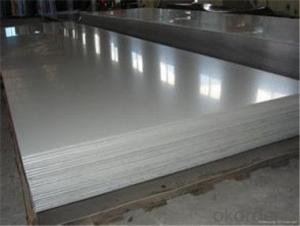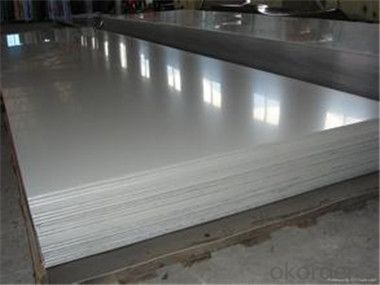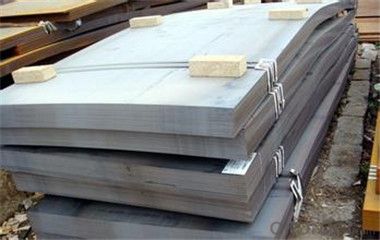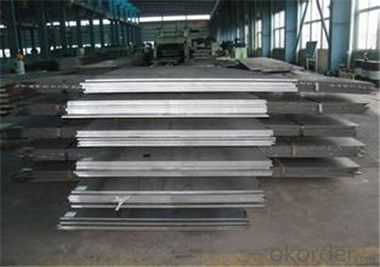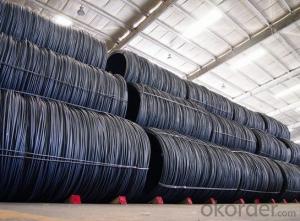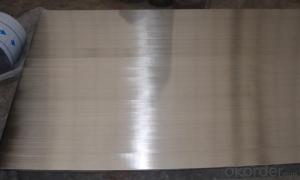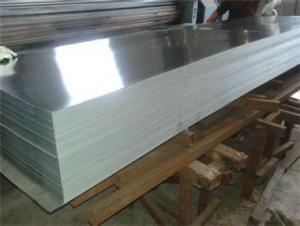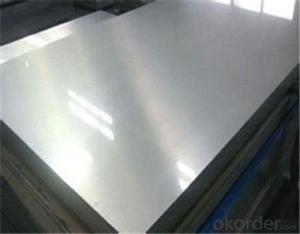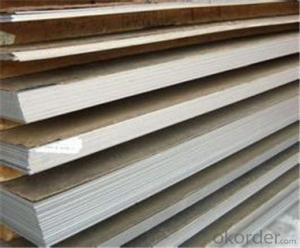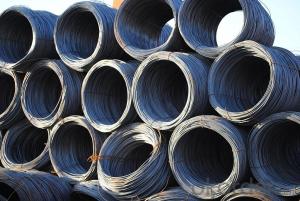Stainless Steel Sheet SS304 with Best Quality in China
- Loading Port:
- Tianjin
- Payment Terms:
- TT OR LC
- Min Order Qty:
- 50 m.t.
- Supply Capability:
- 45555555 m.t./month
OKorder Service Pledge
OKorder Financial Service
You Might Also Like
Specification
Description of stainless steel plate:
stanless steel sheet roll
Manufacturer since 2003;
Origin from Baosteel & Tisco;
100% Manufacture's direct deal.
Festures of stainless steel plate:
| Packaging Details: | standard packing to export 4 eye bands and 3 circumferential bands in steel, galvanized metal fluted rings on inner and outer edges, galvanized metal & waterproof paper wall protection disk, galvanized metal & waterproof paper around circumference |
| Delivery Detail: | 15-25 days after received your deposit or to your quantity |
Specifications of stainless steel plate:
Product Name | cr 1219x2438 stanless steel sheet 201 |
standared | JIS, AISI, ASTM, GB, DIN,SUS |
Thickness | 0.2mm~2.5mm |
Size | 1000*2000mm,1219*2438mm or as per customers' request |
Surface finish | 2B, BA, Hair Line, No.1,No.4, Mirror Finish |
Application | Kitchenware, decoration construction and building ornament, product parts manufacturing and stainless steel products tooling and so on |
Payment terms | T/T 30% for deposit, Balance against the copy of B/L; or L/C at sight |
Product Packing | wooden pallet |
Delivery time | within 15-20 working days after we got your 30% deposit |
Attention | FREE SAMPLES can be sent on request. We promise to provide our valued clients with high quality products, low price, and excellent client services. |
Images of stainless steel plate:
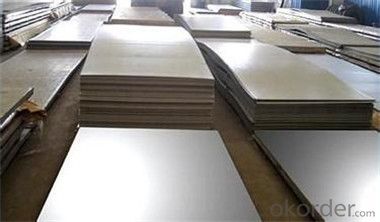
FAQ:
1. What is your package?
Packing situation: standard seaworthy packing or as customer required.
2. How long is the lead time?
Delivery time: 45 days after order confirmed.
3. What payment term do you accept?
Payment: T/T or L/C at sight.
- Q: How is steel wire rod used in the manufacturing of wire shelving?
- Steel wire rod is used in the manufacturing of wire shelving by being shaped and formed into the desired size and shape. It serves as the main structural component, providing strength and stability to the shelves. The wire rod is typically cut, bent, and welded to create the frame and supports of the shelving units, ensuring durability and the ability to hold heavy items.
- Q: What are the common heat treatment processes for steel wire rod?
- There are several common heat treatment processes for steel wire rods, each serving a specific purpose in improving the properties and characteristics of the material. These processes include annealing, quenching, tempering, and normalizing. 1. Annealing: This process involves heating the steel wire rod to a specific temperature and holding it there for a certain duration, followed by controlled cooling. Annealing helps to reduce the hardness and brittleness of the wire rod, improving its ductility and machinability. 2. Quenching: Quenching is a rapid cooling process that involves immersing the heated wire rod into a quenching medium, such as oil or water. This process rapidly hardens the wire rod, increasing its strength and hardness. However, it also makes the material more brittle. 3. Tempering: Tempering is performed after quenching to reduce the brittleness and relieve the internal stresses in the wire rod. It involves heating the quenched wire rod to a specific temperature and holding it there for a certain period, followed by controlled cooling. Tempering enhances the toughness and ductility of the wire rod while maintaining a desirable level of strength. 4. Normalizing: Normalizing is a heat treatment process similar to annealing, but with a slightly different cooling process. It involves heating the wire rod to a specific temperature above its transformation range and allowing it to cool in still air. Normalizing refines the grain structure of the material, improving its mechanical properties and reducing internal stresses. These heat treatment processes can be combined and modified to achieve specific desired properties for steel wire rods. The choice of heat treatment process depends on factors such as the desired mechanical properties, intended application, and the type of steel being treated.
- Q: How is steel wire rod used in the manufacturing of wire for telecommunications cables?
- Wire rod made of steel is an indispensable element in the production of wire for telecommunications cables. The process starts with the creation of steel wire rod, which is a long, cylindrical billet composed of steel. This wire rod is then treated and converted into a wire that is appropriate for telecommunications cables. To manufacture wire for telecommunications cables, various steps are taken with the steel wire rod. Initially, it is purified and descaled to eliminate any impurities that could impact the wire's quality. Subsequently, the wire rod is heated and passed through a series of rollers to decrease its diameter and increase its length. This stage, known as wire drawing, is crucial in achieving the desired thickness and strength of the wire. Once the wire has been drawn to the necessary size, it undergoes further processing to ensure its quality and dependability. The wire is annealed, a process in which it is heated and slowly cooled to relieve internal stresses and improve its flexibility. This makes the wire more suitable for handling and installation in telecommunications cables. Following annealing, the wire is coated with a layer of insulation material, such as polyethylene or polyvinyl chloride (PVC). This insulation provides electrical insulation and safeguards the wire from external factors that could harm its conductivity, such as moisture or extreme temperatures. The final step in the manufacturing process involves twisting multiple wires together to form a cable. Steel wire rod serves as the core strength member within the cable, delivering structural support and tensile strength. This ensures the cable can endure the tension and bending forces it may encounter during installation and operation. In conclusion, steel wire rod plays a crucial role in the production of wire for telecommunications cables. It goes through several processes, including purification, wire drawing, annealing, and insulation, to create a wire suitable for telecommunications applications. The strength and reliability of steel wire rod make it an ideal choice for providing the necessary structural support and durability required in telecommunications cables.
- Q: What are the common impurities found in steel wire rod?
- Common impurities found in steel wire rod include carbon, sulfur, phosphorus, silicon, and manganese.
- Q: How is steel wire rod used in the manufacturing of wire forms for electrical components?
- Steel wire rod is commonly used in the manufacturing of wire forms for electrical components due to its high strength and conductivity. It serves as the raw material that is shaped and manipulated into various wire forms such as coils, springs, and connectors. These wire forms are then used in the production of electrical components such as transformers, motors, and switches. The steel wire rod's properties ensure durability and reliable electrical conductivity, making it an essential material for the manufacturing of wire forms in the electrical industry.
- Q: How is the elongation of steel wire rod determined?
- The elongation of a steel wire rod is determined through a process called tensile testing. Tensile testing involves subjecting the steel wire rod to a controlled pulling force until it reaches its breaking point. During this test, the wire rod is gripped firmly at both ends and a tensile load is gradually applied. As the load is increased, the wire rod begins to elongate due to the applied force. The elongation of the steel wire rod is measured using an extensometer, which is a device that attaches to the specimen and measures the change in length as the load is applied. The extensometer provides precise measurements of the elongation, allowing for accurate determination of the wire rod's properties. The elongation measurement is usually expressed as a percentage, calculated by dividing the change in length by the original length of the wire rod and multiplying by 100. This value provides crucial information about the ductility and tensile strength of the steel wire rod, which are important factors in determining its suitability for various applications. Tensile testing and the determination of elongation are essential in quality control and material selection processes, as they help ensure that the steel wire rod meets the required mechanical properties and performance standards.
- Q: How are steel wire rods used in the production of fishing lines for catching fish?
- Steel wire rods are used in the production of fishing lines for catching fish as they provide strength and durability to withstand the tension generated during the fish-catching process. These wire rods are typically coated or encased in a protective material, ensuring resistance against corrosion and abrasion. This sturdy construction enables fishermen to securely hook and reel in fish of various sizes without the risk of the line breaking.
- Q: What are the main factors influencing the choice of steel wire rod order payment refund options?
- The main factors influencing the choice of steel wire rod order payment refund options can vary depending on various factors. However, some common factors that play a significant role in this decision-making process include: 1. Supplier Reputation: The reputation and trustworthiness of the supplier is a crucial factor. Buyers tend to choose payment refund options that provide them with a sense of security in case of any issues or disputes with the supplier. 2. Order Volume and Value: The size and value of the steel wire rod order can impact the choice of payment refund options. Larger orders with higher values may require more secure refund options to mitigate potential financial risks. 3. Payment Terms and Conditions: The payment terms and conditions set by the supplier can influence the choice of refund options. Some suppliers may offer specific refund options based on their preferred payment methods, such as bank transfers, letters of credit, or escrow services. 4. Buyer's Financial Capability: The financial capability of the buyer can also determine the choice of refund options. Buyers with limited financial resources may opt for payment refund options that offer flexibility and minimize risks, such as installment payments or delayed payment terms. 5. Delivery and Quality Assurance: The reliability and quality assurance provided by the supplier can impact the choice of refund options. Buyers may prefer refund options that allow them to inspect the steel wire rod upon delivery and ensure compliance with the agreed specifications before making full payment. 6. Market Conditions and Competition: Market conditions and competition among suppliers can influence the choice of refund options. Buyers may consider refund options that are more favorable or competitive in the market, such as cash discounts or rebates. 7. Legal and Regulatory Considerations: Legal and regulatory requirements in the buyer's jurisdiction can also affect the choice of refund options. Buyers may opt for refund options that comply with local regulations and provide legal protection in case of any disputes or non-compliance. It is important for buyers to carefully evaluate these factors and assess their specific needs and preferences before deciding on the most suitable payment refund options for their steel wire rod orders.
- Q: How is steel wire rod used in the production of wire mesh for industrial filtration systems?
- Steel wire rod is used in the production of wire mesh for industrial filtration systems as it serves as the raw material for creating the mesh structure. The wire rod is first drawn and processed into various diameters and gauges to achieve the desired strength and flexibility for the wire mesh. These wires are then woven or welded together to form a mesh pattern, creating a sturdy and durable filtration system capable of withstanding high temperatures and pressures.
- Q: How is steel wire rod used in the manufacturing of wire for surgical sutures?
- Steel wire rod is an essential component in the manufacturing process of wire for surgical sutures. The wire rod undergoes several steps to transform it into the high-quality wire used in sutures. Firstly, the steel wire rod is carefully selected to ensure it meets the required specifications for surgical sutures. The rod is typically made of stainless steel, which provides excellent strength, durability, and corrosion resistance. Once the appropriate steel wire rod is chosen, it undergoes a series of processes to shape and refine it. The rod is drawn through a series of dies that progressively reduce its diameter to the desired size for surgical sutures. This process is known as wire drawing and is crucial in achieving the precise diameter and smooth surface required for sutures. After the wire has been drawn to the correct diameter, it is thoroughly cleaned and inspected for any defects or impurities. This ensures that the wire is free from contaminants that could compromise its integrity and safety for medical use. The next step involves coating the wire with a biocompatible material to enhance its performance and reduce any potential adverse reactions within the human body. This coating can be made from various materials, such as silicone or polymers, depending on the specific requirements of the surgical sutures. Once the wire has been coated, it is wound onto spools or bobbins, ready to be further processed into sutures. The wire is carefully handled and packaged in a sterile environment to maintain its cleanliness and prevent any contamination. Finally, the wire is sent to the suture manufacturing facility, where it is cut into precise lengths and further processed to create the final surgical sutures. These sutures are then packaged and sterilized, ready to be used in various surgical procedures. In summary, steel wire rod plays a critical role in the manufacturing of wire for surgical sutures. Through a series of processes, the rod is transformed into high-quality wire with the necessary diameter, surface finish, and biocompatible coating. This wire is then used to produce sterile and reliable sutures that are vital in various medical procedures.
Send your message to us
Stainless Steel Sheet SS304 with Best Quality in China
- Loading Port:
- Tianjin
- Payment Terms:
- TT OR LC
- Min Order Qty:
- 50 m.t.
- Supply Capability:
- 45555555 m.t./month
OKorder Service Pledge
OKorder Financial Service
Similar products
Hot products
Hot Searches
Related keywords
